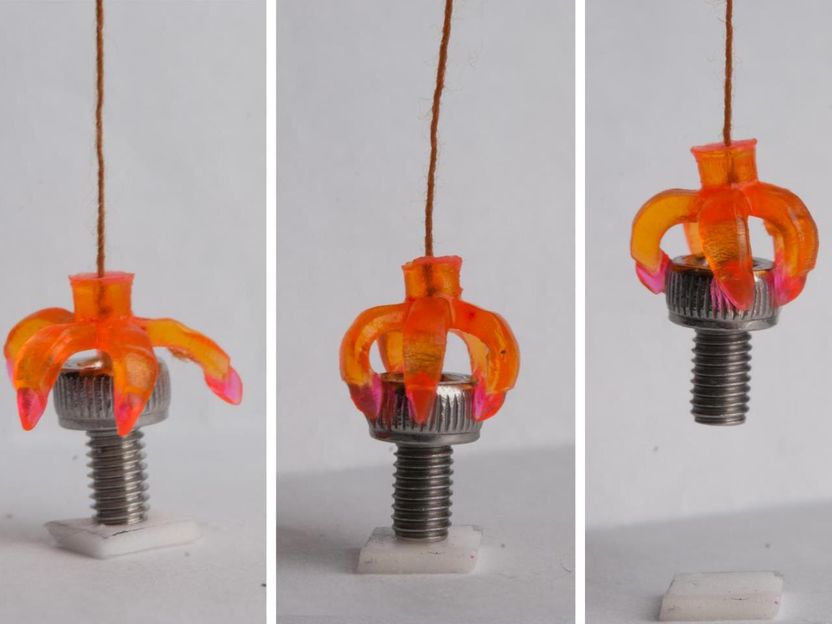Pores with a Memory
Porous polymer films with shape memory
Whether for separation processes, photovoltaics, catalysis, or electronics, porous polymer membranes are needed in many fields. Membranes with micropores that switch between different shapes and/or sizes would expand the possibilities. Scientists have introduced a process that produces porous films made from shape memory polymers with precise dimensions. The shape and size of the pores can be reversibly changed with light. No mechanical deformation is needed.

© Wiley-VCH
Researchers from the East China University of Science and Technology in Shanghai, China; the Georgia Institute of Technology in Atlanta, USA; and Pusan National University in Pusan, South Korea have developed an unconventional strategy to prepare photoswitchable, porous films. Their success stems from a simple method based on condensation patterns known as breath figures. Breath figures are formed when water vapor condenses as a pattern of tiny droplets on a cold solid or liquid surface, like when you breathe onto a cold window. Researchers working with Shaoliang Lin and Zhiqun Lin use this effect to fabricate a block copolymer film with highly ordered honeycomb pores.
One block of the polymer network has photoresponsive side-chains with azobenzene units that change their conformation (cis–trans isomerization) in reaction to light. The other block can be crosslinked to fix the configuration of the film. Irradiation with UV light or heating changes a part of the azobenzene units to the bent cis form, irradiation with visible light causes the groups to preferentially adopt the straight trans form. If the visible light is linearly polarized, the side chains arrange themselves in parallel. This rearrangement causes displacement of the material. Careful control of the direction of polarization allows the researchers to transform the originally round micropores into a variety of different shapes, such as rounded rectangles, or rounded rhombuses.
Irradiation with UV light or heating removes the order of the side chains, returning the pores to their original shape or size. The pores can be switched repeatedly. In addition, the copolymer film can also be firstly photoconfigured to a determined pore shape, and then crosslinked to obtain a photoswitchable film with different initial pore shapes.
The researchers hope to use their new production method to make robust, switchable films for electronics, photonics, efficient separation and purification processes, and functional biomaterials for regenerative therapies.
Original publication
Wei Wang, Dingfeng Shen, Xiao Li, Yuan Yao, Jiaping Lin, Aurelia Wang, Jiwoo Yu, Zhong Lin Wang, Suck Won Hong, Zhiqun Lin, Shaoliang Lin; "Light-Driven Shape-Memory Porous Films with Precisely Controlled Dimensions"; Angew. Chem.; 2018
Wei Wang, Dingfeng Shen, Xiao Li, Yuan Yao, Jiaping Lin, Aurelia Wang, Jiwoo Yu, Zhong Lin Wang, Suck Won Hong, Zhiqun Lin, Shaoliang Lin; "Light-Driven Shape-Memory Porous Films with Precisely Controlled Dimensions"; Angew. Chem. Int. Ed.; 2018
Most read news
Original publication
Wei Wang, Dingfeng Shen, Xiao Li, Yuan Yao, Jiaping Lin, Aurelia Wang, Jiwoo Yu, Zhong Lin Wang, Suck Won Hong, Zhiqun Lin, Shaoliang Lin; "Light-Driven Shape-Memory Porous Films with Precisely Controlled Dimensions"; Angew. Chem.; 2018
Wei Wang, Dingfeng Shen, Xiao Li, Yuan Yao, Jiaping Lin, Aurelia Wang, Jiwoo Yu, Zhong Lin Wang, Suck Won Hong, Zhiqun Lin, Shaoliang Lin; "Light-Driven Shape-Memory Porous Films with Precisely Controlled Dimensions"; Angew. Chem. Int. Ed.; 2018
Topics
Organizations
Other news from the department science
These products might interest you

Eclipse by Wyatt Technology
FFF-MALS system for separation and characterization of macromolecules and nanoparticles
The latest and most innovative FFF system designed for highest usability, robustness and data quality

Spinsolve Benchtop NMR by Magritek
Spinsolve Benchtop NMR
Spinsolve is a revolutionary multinuclear NMR spectrometer that provides the best performance

HYPERION II by Bruker
FT-IR and IR laser imaging (QCL) microscope for research and development
Analyze macroscopic samples with microscopic resolution (5 µm) in seconds

Get the chemical industry in your inbox
By submitting this form you agree that LUMITOS AG will send you the newsletter(s) selected above by email. Your data will not be passed on to third parties. Your data will be stored and processed in accordance with our data protection regulations. LUMITOS may contact you by email for the purpose of advertising or market and opinion surveys. You can revoke your consent at any time without giving reasons to LUMITOS AG, Ernst-Augustin-Str. 2, 12489 Berlin, Germany or by e-mail at revoke@lumitos.com with effect for the future. In addition, each email contains a link to unsubscribe from the corresponding newsletter.





























































